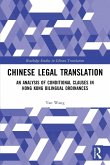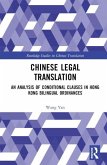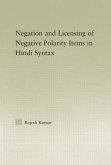Dariush Robertson
Culture Specific Items in Chinese to English Video Game Translation
Transmediality and Interactivity in the Localisation of a Wuxia RPG
Dariush Robertson
Culture Specific Items in Chinese to English Video Game Translation
Transmediality and Interactivity in the Localisation of a Wuxia RPG
- Gebundenes Buch
- Merkliste
- Auf die Merkliste
- Bewerten Bewerten
- Teilen
- Produkt teilen
- Produkterinnerung
- Produkterinnerung
Culture Specific Items in Chinese to English Video Game Translation aims to investigate the Chinese to English translation of culture specific items (CSIs) in the localisation of a wuxia RPG.
Andere Kunden interessierten sich auch für
![Chinese Legal Translation Chinese Legal Translation]() Wang YanChinese Legal Translation57,99 €
Wang YanChinese Legal Translation57,99 €![An Overview of Chinese Translation Studies at the Beginning of the 21st Century An Overview of Chinese Translation Studies at the Beginning of the 21st Century]() Weixiao WeiAn Overview of Chinese Translation Studies at the Beginning of the 21st Century170,99 €
Weixiao WeiAn Overview of Chinese Translation Studies at the Beginning of the 21st Century170,99 €![An Overview of Chinese Translation Studies at the Beginning of the 21st Century An Overview of Chinese Translation Studies at the Beginning of the 21st Century]() Weixiao WeiAn Overview of Chinese Translation Studies at the Beginning of the 21st Century52,99 €
Weixiao WeiAn Overview of Chinese Translation Studies at the Beginning of the 21st Century52,99 €![Chinese Legal Translation Chinese Legal Translation]() Wang YanChinese Legal Translation137,99 €
Wang YanChinese Legal Translation137,99 €![A Corpus-based Analysis of Vocabulary Translation in Teaching Chinese as a Foreign Language A Corpus-based Analysis of Vocabulary Translation in Teaching Chinese as a Foreign Language]() Saihong LiA Corpus-based Analysis of Vocabulary Translation in Teaching Chinese as a Foreign Language179,99 €
Saihong LiA Corpus-based Analysis of Vocabulary Translation in Teaching Chinese as a Foreign Language179,99 €![Yijing (I Ching) Chinese/English Dictionary with Concordance and Translation Yijing (I Ching) Chinese/English Dictionary with Concordance and Translation]() Daniel Claudio BernardoYijing (I Ching) Chinese/English Dictionary with Concordance and Translation74,99 €
Daniel Claudio BernardoYijing (I Ching) Chinese/English Dictionary with Concordance and Translation74,99 €![The Syntax of Negation and the Licensing of Negative Polarity Items in Hindi The Syntax of Negation and the Licensing of Negative Polarity Items in Hindi]() Rajesh KumarThe Syntax of Negation and the Licensing of Negative Polarity Items in Hindi49,99 €
Rajesh KumarThe Syntax of Negation and the Licensing of Negative Polarity Items in Hindi49,99 €-
-
-
Culture Specific Items in Chinese to English Video Game Translation aims to investigate the Chinese to English translation of culture specific items (CSIs) in the localisation of a wuxia RPG.
Produktdetails
- Produktdetails
- Verlag: Routledge
- Seitenzahl: 252
- Erscheinungstermin: 13. Mai 2025
- Englisch
- Abmessung: 240mm x 161mm x 18mm
- Gewicht: 546g
- ISBN-13: 9781032943572
- ISBN-10: 1032943572
- Artikelnr.: 72006990
- Herstellerkennzeichnung
- Libri GmbH
- Europaallee 1
- 36244 Bad Hersfeld
- gpsr@libri.de
- Verlag: Routledge
- Seitenzahl: 252
- Erscheinungstermin: 13. Mai 2025
- Englisch
- Abmessung: 240mm x 161mm x 18mm
- Gewicht: 546g
- ISBN-13: 9781032943572
- ISBN-10: 1032943572
- Artikelnr.: 72006990
- Herstellerkennzeichnung
- Libri GmbH
- Europaallee 1
- 36244 Bad Hersfeld
- gpsr@libri.de
Dariush Robertson, PhD, is a lecturer in Translation Technology at Newcastle University, UK. He previously worked in the localisation industry for a decade, and now, he leads two modules in localisation, one in Chinese to English translation, and covers the Chinese to English component of video game translation and audio-visual translation (AVT).
List of Tables xi
List of Figures xiv
List of Abbreviations xv
Chapter 1. Introduction
1.1 Video Game Industry and Academic Interest
1.2 Barriers of Industry and Academia
1.3 The Rise of Chinese Video Game Localisation
1.4 Aims of the Monograph
1.5 Structure
Chapter 2. Cultural Specificity in Chinese Video Games: Concepts, and
Theory
2.1 Bringing Cultural Specificity to TMIES
2.2 CSIs in Chinese Video Games
2.3 The theoretical underpinning of TMIES
2.4 Summary
Chapter 3. Parameters of the Case Study: Adhering to Industry Practice
3.1 Overview of the Case Study
3.2 Preliminary Stage: Creation of a Generalisable Wuxia RPG Source Text
3.3 Main Stage: Management of Case Study and Collection of Data
Chapter 4. Strategies and Approaches Used to Translate CSIs
4.1 Framework of Strategies and Approaches used in the Translation of CSIs
4.2 Analysis of Translation Behaviour
4.3 Analysis of Approaches Used in Relation to Individual Categories of
CSIs
4.4 Summary of Links Between Categories of CSIs and Cultural Approaches
Chapter 5. The Socio-cultural reasoning behind the Translation of CSIs
5.1 Socio-Cultural Reasoning Driving the Translation of the CSIs
5.2 Overview of Socio-Cultural Reasoning
5.3 Analysis of Socio-Cultural Reasoning in Relation to the Categories of
CSIs
5.4 Summary of Categories of Socio-cultural Reasoning
Chapter 6. Socio-Cultural Reasoning: A Tale of Transmediality and
Interactivity
6.1 Socio-cultural Reasoning That Leads to Stronger Source Culture Adequate
Translation Approaches
6.2 Socio-cultural Reasoning That Leads to Stronger Target Culture
Acceptable Translation Approaches
6.3 Socio-cultural Reasoning That Leads to Stronger Source and Target
Culture Mixed Translation Approaches
6.4 Theoretical Implications for TMIES: Cultural Opacity and Windows of
Interaction
Chapter 7. Conclusion s and Beyond
7.1 Introduction
7.2 Contributions
7.3 Future Research
7.4 Culture Specific Items in Chinese to English Video Game Translation: A
Summary Appendix A: Localisation Kit and Annotated ST
Appendix B: Steps and Procedures Involved in the Localisation Project
Appendix C: Sample Translation
Appendix D: Full List of Keywords Belonging to the Subcategories
References
Gameography
Playthroughs of Wuxia RPGs
Filmography
List of Figures xiv
List of Abbreviations xv
Chapter 1. Introduction
1.1 Video Game Industry and Academic Interest
1.2 Barriers of Industry and Academia
1.3 The Rise of Chinese Video Game Localisation
1.4 Aims of the Monograph
1.5 Structure
Chapter 2. Cultural Specificity in Chinese Video Games: Concepts, and
Theory
2.1 Bringing Cultural Specificity to TMIES
2.2 CSIs in Chinese Video Games
2.3 The theoretical underpinning of TMIES
2.4 Summary
Chapter 3. Parameters of the Case Study: Adhering to Industry Practice
3.1 Overview of the Case Study
3.2 Preliminary Stage: Creation of a Generalisable Wuxia RPG Source Text
3.3 Main Stage: Management of Case Study and Collection of Data
Chapter 4. Strategies and Approaches Used to Translate CSIs
4.1 Framework of Strategies and Approaches used in the Translation of CSIs
4.2 Analysis of Translation Behaviour
4.3 Analysis of Approaches Used in Relation to Individual Categories of
CSIs
4.4 Summary of Links Between Categories of CSIs and Cultural Approaches
Chapter 5. The Socio-cultural reasoning behind the Translation of CSIs
5.1 Socio-Cultural Reasoning Driving the Translation of the CSIs
5.2 Overview of Socio-Cultural Reasoning
5.3 Analysis of Socio-Cultural Reasoning in Relation to the Categories of
CSIs
5.4 Summary of Categories of Socio-cultural Reasoning
Chapter 6. Socio-Cultural Reasoning: A Tale of Transmediality and
Interactivity
6.1 Socio-cultural Reasoning That Leads to Stronger Source Culture Adequate
Translation Approaches
6.2 Socio-cultural Reasoning That Leads to Stronger Target Culture
Acceptable Translation Approaches
6.3 Socio-cultural Reasoning That Leads to Stronger Source and Target
Culture Mixed Translation Approaches
6.4 Theoretical Implications for TMIES: Cultural Opacity and Windows of
Interaction
Chapter 7. Conclusion s and Beyond
7.1 Introduction
7.2 Contributions
7.3 Future Research
7.4 Culture Specific Items in Chinese to English Video Game Translation: A
Summary Appendix A: Localisation Kit and Annotated ST
Appendix B: Steps and Procedures Involved in the Localisation Project
Appendix C: Sample Translation
Appendix D: Full List of Keywords Belonging to the Subcategories
References
Gameography
Playthroughs of Wuxia RPGs
Filmography
List of Tables xi
List of Figures xiv
List of Abbreviations xv
Chapter 1. Introduction
1.1 Video Game Industry and Academic Interest
1.2 Barriers of Industry and Academia
1.3 The Rise of Chinese Video Game Localisation
1.4 Aims of the Monograph
1.5 Structure
Chapter 2. Cultural Specificity in Chinese Video Games: Concepts, and
Theory
2.1 Bringing Cultural Specificity to TMIES
2.2 CSIs in Chinese Video Games
2.3 The theoretical underpinning of TMIES
2.4 Summary
Chapter 3. Parameters of the Case Study: Adhering to Industry Practice
3.1 Overview of the Case Study
3.2 Preliminary Stage: Creation of a Generalisable Wuxia RPG Source Text
3.3 Main Stage: Management of Case Study and Collection of Data
Chapter 4. Strategies and Approaches Used to Translate CSIs
4.1 Framework of Strategies and Approaches used in the Translation of CSIs
4.2 Analysis of Translation Behaviour
4.3 Analysis of Approaches Used in Relation to Individual Categories of
CSIs
4.4 Summary of Links Between Categories of CSIs and Cultural Approaches
Chapter 5. The Socio-cultural reasoning behind the Translation of CSIs
5.1 Socio-Cultural Reasoning Driving the Translation of the CSIs
5.2 Overview of Socio-Cultural Reasoning
5.3 Analysis of Socio-Cultural Reasoning in Relation to the Categories of
CSIs
5.4 Summary of Categories of Socio-cultural Reasoning
Chapter 6. Socio-Cultural Reasoning: A Tale of Transmediality and
Interactivity
6.1 Socio-cultural Reasoning That Leads to Stronger Source Culture Adequate
Translation Approaches
6.2 Socio-cultural Reasoning That Leads to Stronger Target Culture
Acceptable Translation Approaches
6.3 Socio-cultural Reasoning That Leads to Stronger Source and Target
Culture Mixed Translation Approaches
6.4 Theoretical Implications for TMIES: Cultural Opacity and Windows of
Interaction
Chapter 7. Conclusion s and Beyond
7.1 Introduction
7.2 Contributions
7.3 Future Research
7.4 Culture Specific Items in Chinese to English Video Game Translation: A
Summary Appendix A: Localisation Kit and Annotated ST
Appendix B: Steps and Procedures Involved in the Localisation Project
Appendix C: Sample Translation
Appendix D: Full List of Keywords Belonging to the Subcategories
References
Gameography
Playthroughs of Wuxia RPGs
Filmography
List of Figures xiv
List of Abbreviations xv
Chapter 1. Introduction
1.1 Video Game Industry and Academic Interest
1.2 Barriers of Industry and Academia
1.3 The Rise of Chinese Video Game Localisation
1.4 Aims of the Monograph
1.5 Structure
Chapter 2. Cultural Specificity in Chinese Video Games: Concepts, and
Theory
2.1 Bringing Cultural Specificity to TMIES
2.2 CSIs in Chinese Video Games
2.3 The theoretical underpinning of TMIES
2.4 Summary
Chapter 3. Parameters of the Case Study: Adhering to Industry Practice
3.1 Overview of the Case Study
3.2 Preliminary Stage: Creation of a Generalisable Wuxia RPG Source Text
3.3 Main Stage: Management of Case Study and Collection of Data
Chapter 4. Strategies and Approaches Used to Translate CSIs
4.1 Framework of Strategies and Approaches used in the Translation of CSIs
4.2 Analysis of Translation Behaviour
4.3 Analysis of Approaches Used in Relation to Individual Categories of
CSIs
4.4 Summary of Links Between Categories of CSIs and Cultural Approaches
Chapter 5. The Socio-cultural reasoning behind the Translation of CSIs
5.1 Socio-Cultural Reasoning Driving the Translation of the CSIs
5.2 Overview of Socio-Cultural Reasoning
5.3 Analysis of Socio-Cultural Reasoning in Relation to the Categories of
CSIs
5.4 Summary of Categories of Socio-cultural Reasoning
Chapter 6. Socio-Cultural Reasoning: A Tale of Transmediality and
Interactivity
6.1 Socio-cultural Reasoning That Leads to Stronger Source Culture Adequate
Translation Approaches
6.2 Socio-cultural Reasoning That Leads to Stronger Target Culture
Acceptable Translation Approaches
6.3 Socio-cultural Reasoning That Leads to Stronger Source and Target
Culture Mixed Translation Approaches
6.4 Theoretical Implications for TMIES: Cultural Opacity and Windows of
Interaction
Chapter 7. Conclusion s and Beyond
7.1 Introduction
7.2 Contributions
7.3 Future Research
7.4 Culture Specific Items in Chinese to English Video Game Translation: A
Summary Appendix A: Localisation Kit and Annotated ST
Appendix B: Steps and Procedures Involved in the Localisation Project
Appendix C: Sample Translation
Appendix D: Full List of Keywords Belonging to the Subcategories
References
Gameography
Playthroughs of Wuxia RPGs
Filmography









